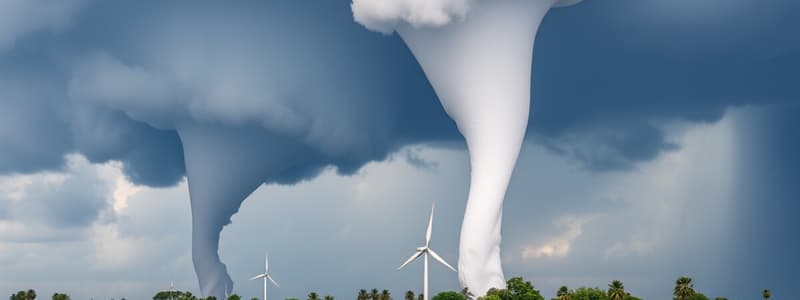Podcast
Questions and Answers
What characterizes a tropical cyclone?
What characterizes a tropical cyclone?
- Strong winds and heavy rain with a distinct low-pressure center (correct)
- Cooling winds from the Northeast
- Seasonal variation of wind patterns
- Violently rotating columns of air
Monsoons only bring dry winds and do not affect precipitation.
Monsoons only bring dry winds and do not affect precipitation.
False (B)
What causes tidal flooding?
What causes tidal flooding?
Local tides being high enough to reach the coast.
The _____ Tide creates higher and lower tides due to the alignment of the sun and moon.
The _____ Tide creates higher and lower tides due to the alignment of the sun and moon.
Match the following terms with their definitions:
Match the following terms with their definitions:
Flashcards are hidden until you start studying
Study Notes
Tropical Cyclones
- Characterized by strong winds, heavy rain, and a distinct low-pressure center.
- Formed over warm tropical oceans and have well-defined structures.
Tornadoes
- Violently rotating columns of air extending from thunderstorms to the ground.
- Vary in size and intensity, typically forming in severe weather conditions.
Hazards Associated with Tropical Cyclones and Tornadoes
- Flooding: The overflow of water into normally dry areas, often as a result of heavy rainfall.
- Storm Surge: The rise in sea level due to low pressure over the sea, leading to coastal flooding.
Monsoons
- Seasonal variations in wind patterns that significantly affect precipitation and surface temperatures.
- Amihan (Northeastern Wind): Cool, dry winds typically from September to June, associated with fair weather.
- Habagat (Southwest Wind): Hot, humid winds that occur for the remainder of the year following Amihan.
Waves and Tides
- Waves: Manifest as energy transfer in water, resulting in moving surface patterns.
- Tides: Cyclical changes in sea level due to gravitational forces from the moon and sun.
Tidal Variations
- Spring Tide: Occurs when the sun and moon align, producing higher high tides and lower low tides.
- Neap Tide: Happens when the sun and moon are at right angles, resulting in lower tide variations.
Hazards of Waves and Tides
- Tsunami: Large waves generated by underwater displacements, such as earthquakes or volcanic eruptions.
- Tidal Flooding: Occurs when local tides rise sufficiently to inundate coastal areas, often exacerbated by storm surges.
Hazard Maps
- Tools used to identify areas at high risk for specific natural hazards.
- Risk assessment depends on factors like proximity to the hazard source and the frequency probability of events.
Studying That Suits You
Use AI to generate personalized quizzes and flashcards to suit your learning preferences.





